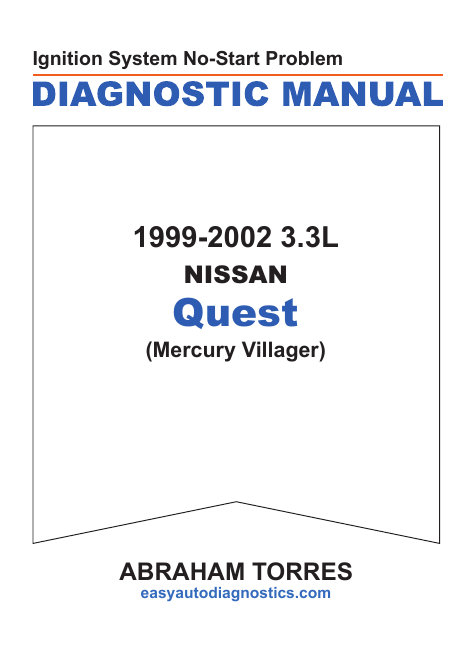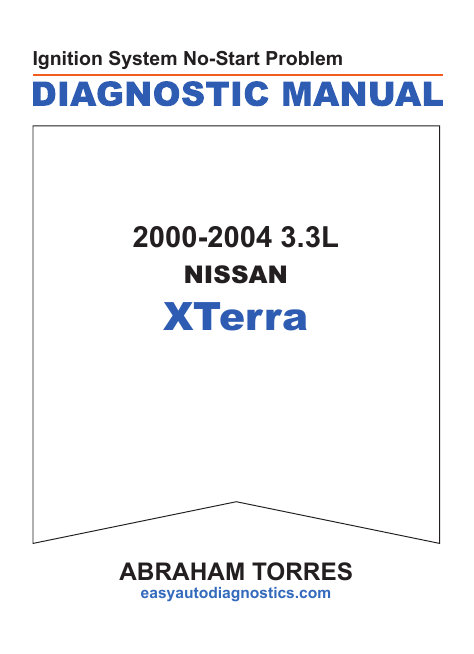
The camshaft position sensor is inside the distributor on your 3.3L V6 Nissan Frontier, Pathfinder, and Xterra. It produces two position signals and both can be easily tested with an LED light (you don't need any expensive test equipment).
And in this tutorial, I'll explain how to do this LED light test. With your test results you'll be able to find out if camshaft position sensor is bad or not.
Contents of this tutorial:
- Important Tips And Suggestions.
- How Does The Camshaft Position Sensor Work?
- Ignition System Diagnostic Manual Download.
- TEST 1: Making Sure The Camshaft Position Sensor Is Getting Power.
- TEST 2: Making Sure The Camshaft Position Sensor Is Getting Ground.
- TEST 3: Testing The 120° REF Signal.
- TEST 4: Testing The 1° POS Signal.
- Where To Buy The Distributor And Save.
- More Nissan 3.3L V6 Tutorials.
![]() You can find this tutorial in Spanish here: Cómo Probar El Sensor De La Posición Del Árbol De Levas (3.3L V6 Frontier, Quest, Pathfinder, Xterra) (at: autotecnico-online.com).
You can find this tutorial in Spanish here: Cómo Probar El Sensor De La Posición Del Árbol De Levas (3.3L V6 Frontier, Quest, Pathfinder, Xterra) (at: autotecnico-online.com).
This tutorial applies to the following vehicles:
- 3.3L Infiniti QX-4: 1997, 1998, 1999, 2000.
- 3.3L Nissan Frontier: 1999, 2000, 2001, 2002, 2003, 2004.
- 3.3L Nissan Quest and Mercury Villager: 1999, 2000, 2001, 2002.
- 3.3L Nissan Pathfinder: 1996, 1997, 1998, 1999, 2000.
- 3.3L Nissan Xterra: 2000, 2001, 2002, 2003, 2004.
NOTE: You can find the ignition coil and power transistor test here: Power Transistor Test And Ignition Coil Test 3.3L Nissan (1996-2004).
You can find the ignition system wiring diagram for the 3.3L Nissan Frontier, Xterra, Pathfinder (QX-4) here:
- Ignition System Wiring Diagram (1999-2004 3.3L Frontier And Xterra).
- Ignition System Wiring Diagram (1996-2000 3.3L Pathfinder) (includes Infiniti QX-4).
- Ignition System Wiring Diagram (1999-2002 3.3L Nissan Quest) (includes Mercury Villager) (at: troubleshootmyvehicle.com).
Important Tips And Suggestions
TIP 1: The tests that you are about to do, with the LED light, require that you turn the engine by hand. To be a bit more specific, you cannot use the starter motor to crank the engine to perform TEST 3 and TEST 4.
TIP 2: The fuel system must be disabled before you do TEST 3 and TEST 4. You can easily do this by removing the fuel pump fuse.
The fuel pump fuse location:
- 1997-2000 3.3L Infiniti QX-4: fuse #17 of the dash fuse box.
- 1999-2002 3.3L Mercury Villager: fuse #43 of the engine compartment fuse box.
- 1999-2004 3.3L Nissan Frontier: fuse #1 of the dash fuse box.
- 1999-2002 3.3L Nissan Quest: fuse #43 of the engine compartment fuse box.
- 1996-2000 3.3L Nissan Pathfinder: fuse #17 of the dash fuse box.
- 2000-2004 3.3L Nissan Xterra: fuse #1 of the dash fuse box.
TIP 3: Before you test the camshaft position sensor, you must first test the ignition coil. If the ignition coil sparks then you can conclude that the camshaft position sensor is good and functioning correctly.
The ignition coil test is not hard to and you can find it here: Power Transistor Test And Ignition Coil Test 3.3L Nissan (1996-2004).
TIP 4: If it turns out that the camshaft position sensor is bad, you're gonna' have to buy the whole distributor, since Nissan in all its wisdom, does not license any of the components to be sold separately.
How Does The Camshaft Position Sensor Work?
Here's a very brief description of how the camshaft position (CMP) sensor works:
- The camshaft position sensor is located inside the distributor and is part of the power transistor assembly.
- The cam sensor assembly is really a crankshaft position sensor, since the fuel injection computer uses it to control the creation of spark (thru') the power transistor and ignition coil.
- Now, when you turn the key and crank the engine (to start it), the cam sensor/power transistor get power thru' the wire labeled with the number 5.
- As the engine turns, the cam sensor assembly starts to create two specific position signals that it sends directly to the computer. One signal is called the 1° POS signal and the other is called the 120° REF signal.
- When the computer gets these two cam signals, it does its little song and dance and shoots an activation signal to the power transistor.
- This power transistor activation signal can be checked with an LED Light (which you can do in: Power Transistor Test And Ignition Coil Test 3.3L Nissan (1996-2004)).
- When the power transistor gets its activation signal from the fuel injection computer, it now starts to switch the ignition coil's power ON and OFF. This ON/OFF action is what makes the ignition coil spark and is referred to as the switching signal.
When the camshaft position sensor fails on your 3.3L Nissan Frontier, Pathfinder, or Xterra; the engine is not going to start due to a lack of spark.
You're also going to see a P0340 trouble code registered in the fuel injection computer. This code will light up the check engine light on your Nissan instrument cluster.
Ignition System Diagnostic Manual Download
If you'd like to have access to a wiring diagram, ignition component connector pin-outs, and the entire testing procedure (for a no-start caused by a bad CMP sensor) in one place, then take a look at the following diagnostic manuals in downloadable PDF format:

1999-2004 3.3L Frontier
Ignition System No-Start Problem Diagnostic Manual
$3.99 USD
All of the diagnostic information you need in one place to diagnose a no-start problem caused by the power transistor (ignition control module), or the ignition coil, or the camshaft position sensor.
Also includes diagnostic tests to find out if the ignition system is causing a misfire problem.
Diagnostic manual comes with:
- Wiring diagram.
- Component pin outs.
- Connector pin outs.
- Complete step-by-step testing instructions.
- 31 pages.
The illustrations in the diagnostic manual are printer friendly!

1996-2000 3.3L Pathfinder
Ignition System No-Start Problem Diagnostic Manual
$3.99 USD
All of the diagnostic information you need in one place to diagnose a no-start problem caused by the power transistor (ignition control module), or the ignition coil, or the camshaft position sensor.
Also includes diagnostic tests to find out if the ignition system is causing a misfire problem.
Diagnostic manual comes with:
- Wiring diagram.
- Component pin outs.
- Connector pin outs.
- Complete step-by-step testing instructions.
- 31 pages.
The illustrations in the diagnostic manual are printer friendly!

1999-2002 3.3L Quest
1999-2002 3.3L Villager
Ignition System No-Start Problem Diagnostic Manual
$3.99 USD
All of the diagnostic information you need in one place to diagnose a no-start problem caused by the power transistor (ignition control module), or the ignition coil, or the camshaft position sensor.
Also includes diagnostic tests to find out if the ignition system is causing a misfire problem.
Diagnostic manual comes with:
- Wiring diagram.
- Component pin outs.
- Connector pin outs.
- Complete step-by-step testing instructions.
- 31 pages.
The illustrations in the diagnostic manual are printer friendly!

2000-2004 3.3L XTerra
Ignition System No-Start Problem Diagnostic Manual
$3.99 USD
All of the diagnostic information you need in one place to diagnose a no-start problem caused by the power transistor (ignition control module), or the ignition coil, or the camshaft position sensor.
Also includes diagnostic tests to find out if the ignition system is causing a misfire problem.
Diagnostic manual comes with:
- Wiring diagram.
- Component pin outs.
- Connector pin outs.
- Complete step-by-step testing instructions.
- 31 pages.
The illustrations in the diagnostic manual are printer friendly!
TEST 1: Making Sure The Camshaft Position Sensor Is Getting Power

In this first test we're gonna' make sure that the camshaft position sensor is getting 10 to 12 Volts.
The wire that feeds these 12 Volts to the camshaft position sensor is the one labeled with the number 5.
On the Frontier and Xterra, this wire is the black with pink stripe (BLK/PNK) wire of the distributor's 6-wire electrical connector.
On the Quest, QX-4, Pathfinder, and Villager; this wire is the black with white stripe (BLK/WHT) wire of the distributor's 6-wire electrical connector.
If these 12 Volts are present then the next step is to make sure the camshaft position sensor is getting Ground.
These are the test steps:
- 1
Set your multimeter to Volts DC mode.
- 2
Disconnect the 6 wire connector from the distributor.
- 3
Probe the wire labeled with the number 5 with the red multimeter test lead.
- 4
Connect the black multimeter test lead directly on the battery negative (-) terminal.
- 5
Turn the key on but don't crank the engine.
- 6
Your multimeter should register 10 to 12 Volts DC.
Let's examine your test result:
CASE 1: Your multimeter registered 10 to 12 Volts. This is the correct test result.
This result confirms that the camshaft position sensor is getting power. The next step is to make sure that it's getting Ground. Go to: TEST 2: Making Sure The Cam Sensor Is Getting Ground.
CASE 2: Your multimeter DID NOT register 10 to 12 Volts. Without this voltage the camshaft position sensor will not function.
Your next step find out why this voltage is missing and repair the problem. The following ignition system wiring diagrams will help you trace down the problem:
- Ignition System Wiring Diagram (1999-2004 3.3L Frontier And Xterra).
- Ignition System Wiring Diagram (1996-2000 3.3L Pathfinder) (includes Infiniti QX-4).
- Ignition System Wiring Diagram (1999-2002 3.3L Nissan Quest) (includes Mercury Villager) (at: troubleshootmyvehicle.com).
